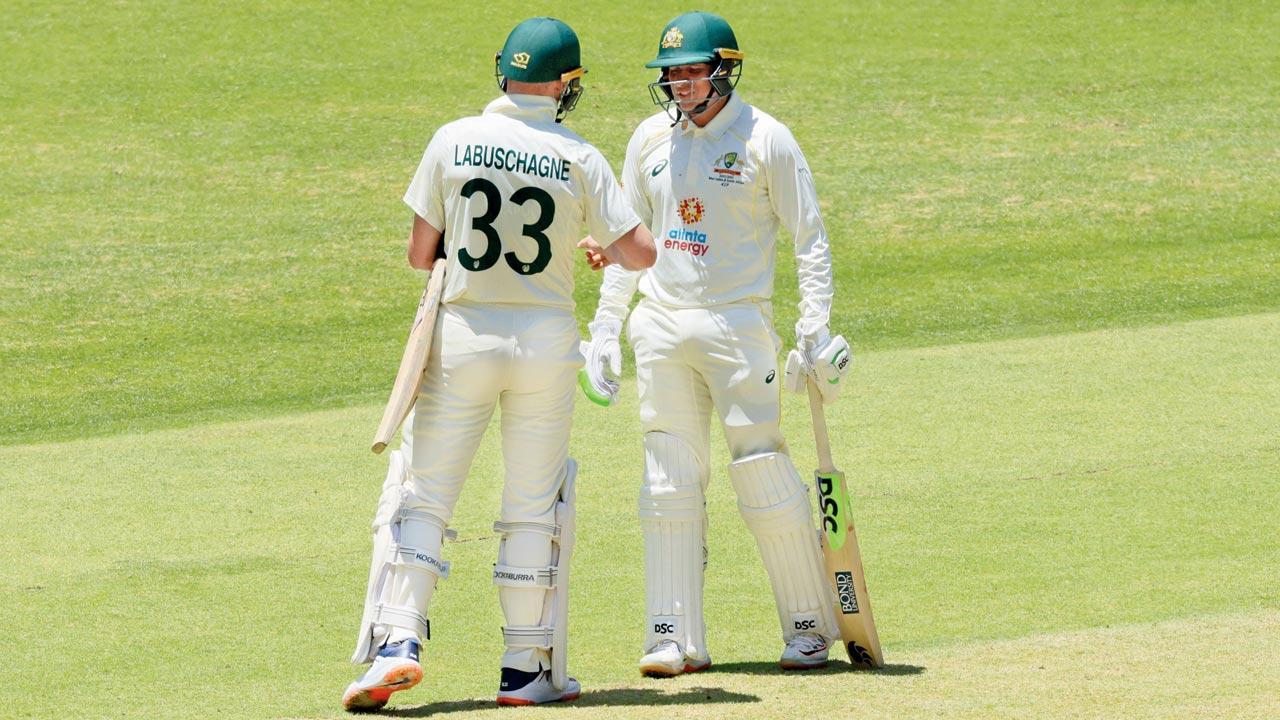There are valid arguments about the increasing costs and for the introduction of four-day Tests, but why isn’t the tardy pace of play being addressed? It is slowing every day

Australian batsmen Marnus Labuschagne (left) and Usman Khawaja talk mid-pitch during the first day of the opening Test against the West Indies at Perth on November 30, 2022. The author feels chats like these affect the pace of the game. Pic/AFP
 It’s no secret that Test cricket is an endangered species. Administrators are enamoured with T20’s popularity and its huge financial rewards; there’s been a worldwide explosion of T20 leagues and now players are signing long-term contracts with major T20 franchises. These are all contributing factors.
It’s no secret that Test cricket is an endangered species. Administrators are enamoured with T20’s popularity and its huge financial rewards; there’s been a worldwide explosion of T20 leagues and now players are signing long-term contracts with major T20 franchises. These are all contributing factors.
ADVERTISEMENT
However, the list also includes the exorbitant cost of preparing cricketers through longer form first-class competition and a lack of competitiveness among a number of Test-playing nations.
Discussion is gaining momentum for four-day Tests following the number of five-day games that last slightly longer than a 50-over match. There are valid arguments about the increasing costs and for the introduction of four-day Tests, but why isn’t the tardy pace of play being addressed?
The pace of play in Test cricket is abysmal. It’s slowing every day and yet nothing is being done to improve matters. On the one hand, Ben Stokes genuinely strives to improve the entertainment quotient of Test cricket but he’s being undermined by the administration’s lack of initiative.
Why are batsmen allowed to meet mid-pitch during overs to discuss who knows what, without penalty? Why aren’t batsmen informed that etiquette requires them to be in their stance at the crease when a bowler is ready to deliver? Heat extremes excepted, why allow drinks at times outside of the regular break? Why do glove changes occur so often? Surely this is superstition more so than need. Why aren’t boundaries signalled only for balls that hit the rope rather than allowing pointless replays to see the whereabouts of a fielder’s feet or hands?
Have administrators heard how players shouldn’t argue with an umpire? Then why do those same administrators encourage arguing with an umpire by allowing players to review decisions? The number of tactical reviews is growing out of hand and replays are taking too much time.
How come players are allowed to charge at umpires whilst they are appealing without any recrimination? I was appalled to see Australian players indulging in this heinous behaviour in the SCG Test. This bad habit should be subject to penalty.
How can it be fair that a bowler has to nominate his method of delivery through the umpire [right or left arm, over or round the wicket] but a batsman can face up left-handed but then change to play a right-handed shot?
There’s one main reason why—to undermine the field placings. There is no doubt it’s skilful but it’s not fair. Fairness should be a consideration when framing cricket’s laws. A batsman shouldn’t be allowed to change the order of his hands or feet.
When did using your feet cleverly become more dangerous than playing a premeditated sweep shot?
The ridiculous combination of much-improved bats and shorter boundaries must have been devised by people who consider bowlers a necessary evil. Either that or they are delusional about the resultant escalation in sixes that excite fans who pay entrance money. That and the huge rights fees that T20 leagues attract can be the only reason why a ludicrous imbalance in playing conditions is maintained.
A game-time clock is being trialled to ensure that white-ball cricket moves at a respectable speed. It would be better if games flowed naturally because the administrators adjudicated responsibly to ensure all matches moved at an acceptable pace.
When was the last time the stipulated minimum number of overs were completed in the regular time allocated for a Test day’s play? Six hours of cricket is ample—for players, the fans, the viewers and administrators. Everything should be done to avoid the game enduring overtime. Overtime is one of the more boring aspects of cricket.
Cricket needs to operate as a partnership between players and administrators. It’s about time that relationship was formalised and the game was allowed to
grow accordingly.
There is no doubt cricket’s move into the modern era leaves some former players flummoxed. Nevertheless, there is nothing wrong with administrators displaying
decision-making strength that is backed by cricketing common sense.
Ian Chappell, a former Australia captain, is one of the most respected voices in the game
Ajaz Ashraf’s Monday Blues will be back next week
Send your feedback to mailbag@mid-day.com
The views expressed in this column are the individual’s and don’t represent those of the paper
 Subscribe today by clicking the link and stay updated with the latest news!" Click here!
Subscribe today by clicking the link and stay updated with the latest news!" Click here!







